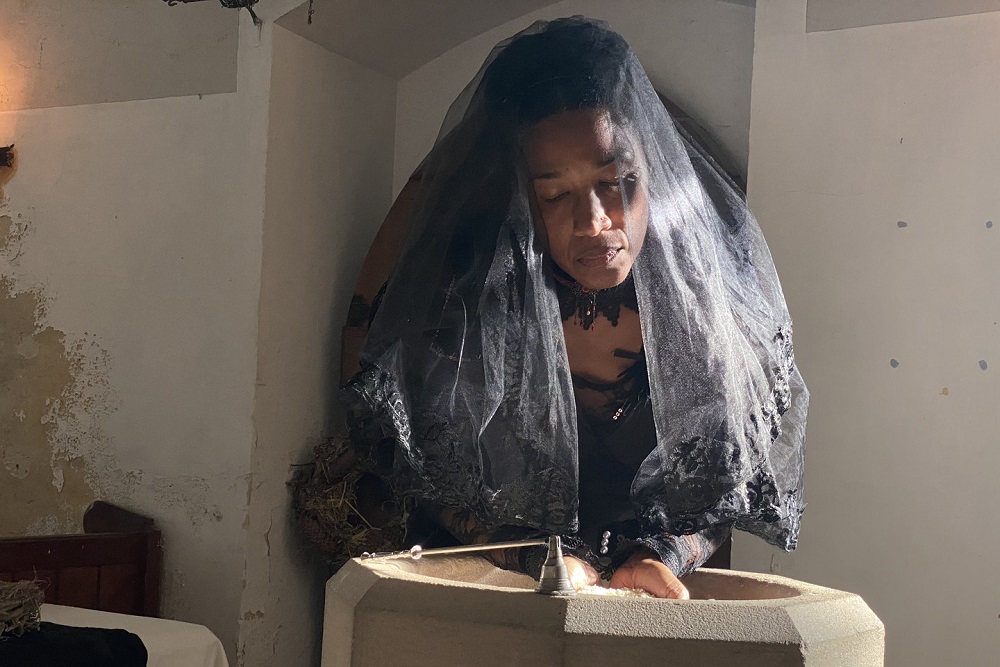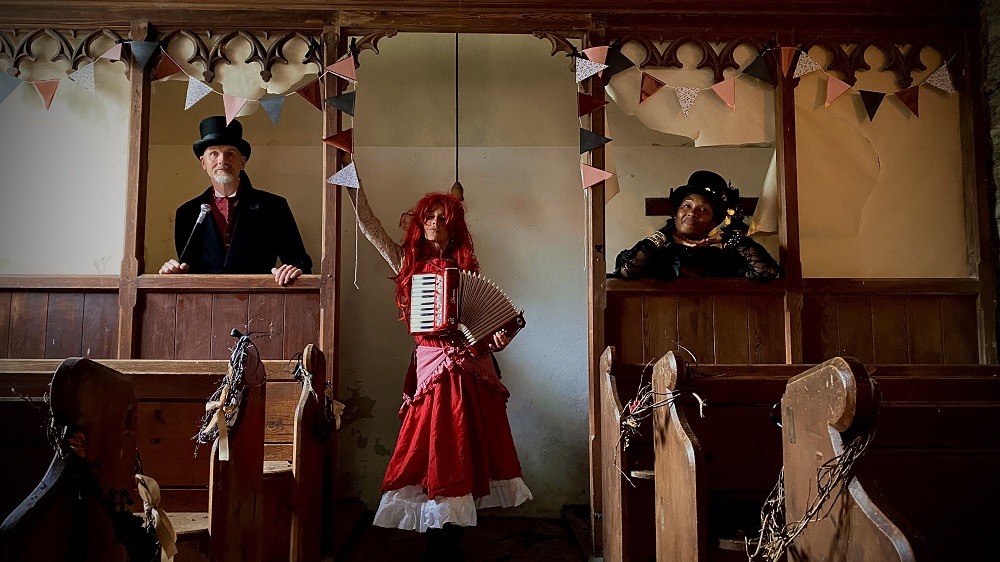Review: ‘A Signal Across Space / Arwydd Drwy’r Awyr’

Jon Gower
Tracy Spottiswoode has a history in immersive theatre, so her recent move into making 360 virtual reality experiences makes a lot of sense. The Cardiff-based film-maker’s latest work, the bilingual ‘A Signal Across Space / Arwydd Drwy’r Awyr’ assembles the talents of sound artist Marie Tueje and physical performers Marega Palser, Mary-Anne Roberts and Gareth Clark who meld and move their way through a mixture of folk stories and historical events at Lavernock on the south Wales coast.
One such story tells of a heartbroken mariner thwarted in love while the other is the macabre tale which gives its name to the nearby ‘Captain’s Wife’ pub. Both were featured in the first instalment of the work A Frequency At Lavernock – Amledd Yn Larnog, which was previously reviewed on Nation.Cymru.
This was inspired by the story of the first ever Morse Code wireless message, sent across a stretch of sea between Flat Holm island and Lavernock by Guglielmo Marconi in 1897.
The expanded work melding together the half a dozen new pieces in this world premiere runs to almost an hour’s duration and utilizes some splendid and evocative locations in the Lavernock area such as the former St Lawrence Church on Fort Road.
These new chapters of ‘A Signal Across Space / Arwydd Drwy’r Awyr’ feature elements seemingly influenced by the extravagant ceremonial procedures of mummery, reminding one of the poet Tony Conran’s dance-inflected version of the tale of Branwen in which he unexpectedly brought Morris Dancing into the Mabinogi.
Unexpected
“Unexpected” might be the watchword for Spottiswoode’s conjuring up of virtual reality. In ‘Wavelength Shift’ a man wearing a fertility head decoration made of straw sweeps up leaves from the church floor, a task much like that in the Sisyphus myth where he rolls a huge rock uphill only to see it roll down again when it reaches the top. Only here more leaves blow in from outside as the straw man clears the ones inside.
One thinks of the many churches the other side of the Severn Sea which are decorated with a Green Man, that old, old symbol of regeneration and rebirth, connecting with them much as Marconi’s message did the mainland and a hump of offshore rock.
The pieces in Spottiswoode’s engaging assemblage are often skewed, off kilter, as a priest or minister rises into the pulpit to deliver a sermon but does so backwards, words and all. There are voices off, as we hear a dislocated, fractured lecture from what seems to be the Barry and District Radio Society about Marconi’s experiment coming appropriately through the ether.
A woman in white, a spectral bride perhaps, drags her body along the aisle. Things creep up on you, taking full advantage of the 360 panorama available. An organist, her face veiled, plays an asthmatic version of ‘No Place Like Home,’ a song which had drifted into the soundtrack of the work very early on. There are lots of unexpected touches and touches of the unexpected.
Elegant
Taken together these varied and various chapters bear out the sentiment in David Shield’s provocative book ‘Reality Hunger’ that art nowadays is often typified by collage and mash up. And these are lovely collages and elegant mash-ups, with the ancient church dressed much as a theatrical set, or the Second World War gun battery at Lavernock acting as a much more peaceful backdrop for redacting stories.
The ‘Greenwood Mass’ section has as its backbone the rhyming couplets of the medieval poet Dafydd ap Gwilym’s ‘Offeren y Llwyn,’ ‘The Woodland Mass’ and for this the little church is bedecked in ivy and strewn with apples, portending a change of seasons.
The words are sung by Mary-Anne Roberts, elsewhere one half of the Celtic medievalist duo Bragod, while two dancers, two lovers dance a slow gavotte to the intoning of the words. One of the loveliest touches in the work is the way in which there are often visual rhymes, dancers’ gestures from one piece being repeated much later, helping bind the pieces together like corn dollies.
There’s a sense of ritual in many of the sections, not least ‘In Memorium’ in which a woman burns incense as if summoning the spirit of a loved one. She might be one of the doomed lovers of the opening trio of stories, or have a story of tainted love all of her own. It doesn’t really matter, as very often poetry derives from ambivalence.

A change of tone comes with a jaunty song-section called ‘In The Air’ telling the story of how Guglielmo Marconi came to transmit his message connecting a small island in the Bristol Channel with the mainland at Lavernock in the first place, the performers spiritedly belting out something that sounds like Italian café music, complete with sprightly accordion accompaniment.
The last substantive section takes its name from the Trinidadian song “Sereno Será” and is the nearest piece to conventional storytelling within all of the various sections.
Simply told by a woman pouring drinks, it is a story about women’s gossip before they set to work for the day, and how a mother with 13 children still finds time to embrace them all and care for them. It also conjures up the dances in which women’s feet burnished up the beans they had collected before taking them to market and is full of the aroma of the beans themselves as they bake on the roof.

This comes before a brief section which dwells on the commemorative stone near the church, marking the historical messaging occasion at Lavernock which helped give birth to the telecommunications age.
A Signal Across Space / Arwydd Drwy’r Awyr is a rich, nuanced and satisfyingly complex piece, or set of pieces, full of poetry both visual and verbal along with elegant movement, restrained mime and textured music and sound.
There’s so much going on all around you that there might be some things you miss, but that doesn’t matter much, as you’ll reap plenty of rewards from what you do see as you look all around, and do so quite literally.
You can experience A Signal Across Space / Arwydd Drwy’r Awyr at the specially designed Bocs at the Wales Millennium Centre. It runs until the 20th November.
Support our Nation today
For the price of a cup of coffee a month you can help us create an independent, not-for-profit, national news service for the people of Wales, by the people of Wales.




